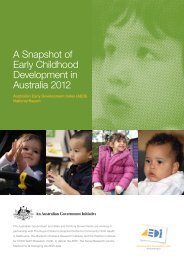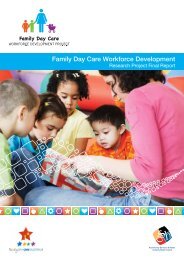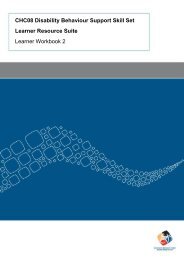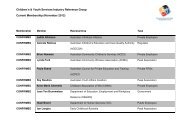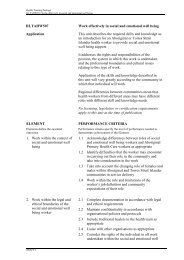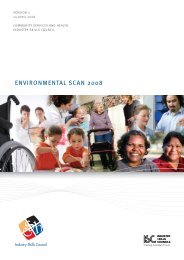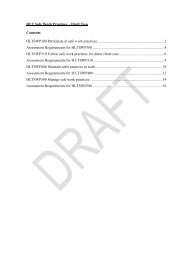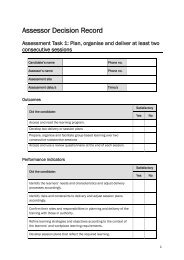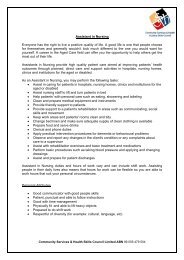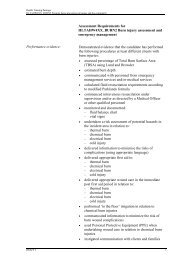2013 Environmental Scan - Community Services & Health Industry ...
2013 Environmental Scan - Community Services & Health Industry ...
2013 Environmental Scan - Community Services & Health Industry ...
You also want an ePaper? Increase the reach of your titles
YUMPU automatically turns print PDFs into web optimized ePapers that Google loves.
CURRENT IMPACT OF<br />
TRAINING PACKAGES<br />
THE CARE INDUSTRY – A TIME FOR ACTION<br />
This section reports on the latest public<br />
data available on the use of the <strong>Community</strong><br />
<strong>Services</strong> and <strong>Health</strong> Training Packages<br />
and outlines the work being conducted by<br />
CS&HISC on workforce development and<br />
the review of qualifications and competency<br />
standards. The data indicates that in 2011<br />
(last year of available data) there was<br />
continued growth in <strong>Community</strong> <strong>Services</strong><br />
Training Package enrolments and a small<br />
decline in the number of <strong>Health</strong> Training<br />
Package enrolments. Limited evidence is<br />
available to report on the broader impact<br />
of training packages.<br />
There are industry concerns about<br />
the quality of training stemming<br />
from accelerating training system<br />
throughput, increasing use of e-learning<br />
and simulated environments. Clearly<br />
technology will increasingly be used in<br />
training but will need to be balanced to<br />
ensure quality training and outcomes are<br />
achieved. CS&HISC believes that there is:<br />
ww<br />
Support from the industry to be more<br />
involved with training through work<br />
placements, workplace supervision<br />
and work based assessment<br />
ww<br />
Potential for job redesign across<br />
community services and health, within<br />
a broader framework that assists<br />
workforce development initiatives.<br />
In 2012, CS&HISC greatly expanded<br />
its workforce development activities<br />
and outreach to provide a localised<br />
workforce planning and capacity building<br />
infrastructure as a service to the<br />
industry. Work placements and training<br />
packages are viewed by the industry as<br />
integral to skill development and assist in<br />
defining scopes of practice and skill mix.<br />
CS&HISC is undertaking a major review<br />
of the <strong>Community</strong> <strong>Services</strong> and <strong>Health</strong><br />
Training Packages to ensure workplace<br />
assessment and work placement become<br />
integral to the training system. CS&HISC<br />
has also currently started a project to<br />
engage with industry to improve the<br />
quality of training.<br />
TRAINING PACKAGE<br />
UPTAKE<br />
The most recently available national data<br />
for enrolments in publicly funded Vocational<br />
and Educational Training (VET) is for 2011.<br />
Publicly funded enrolments in the CS&HISC<br />
training packages were mixed in 2011. As<br />
illustrated in Table 4, course enrolments in<br />
the <strong>Community</strong> <strong>Services</strong> (CHC) Training<br />
Package continued to increase in 2011,<br />
with 201,233 enrolments, up 16.57 per<br />
cent from 2010, while course enrolments<br />
in the <strong>Health</strong> (HLT) Training Package in<br />
2011 were 66,800, a small decrease of<br />
3.6 per cent from 2010.<br />
There were 16,241 Indigenous enrolments<br />
in Australia for the <strong>Community</strong> <strong>Services</strong><br />
and <strong>Health</strong> Training Packages in 2011.<br />
This figure was up 21.81 per cent on<br />
enrolments in 2010, and formed 6.05 per<br />
cent of total enrolments.<br />
The data allows a very preliminary<br />
examination of the impact of entitlement<br />
models on demand for qualifications<br />
in health and community services. The<br />
figures incorporate twelve months’<br />
operation of the Victorian entitlement<br />
model. South Australia, the next State to<br />
transition to an entitlement model, only<br />
commenced its new system in July 2012.<br />
We expect the number of students in<br />
<strong>Community</strong> <strong>Services</strong> Training Package<br />
courses and qualifications to continue<br />
a sharp trajectory of growth, as the new<br />
training package becomes embedded<br />
in the sector. The number of students<br />
increased by 19 per cent nationwide,<br />
while the increase in Victoria was slightly<br />
higher (22%) (see Figure 4).<br />
Children’s <strong>Services</strong>, Aged Care and<br />
general community services qualifications<br />
continue to be the largest sectors for<br />
training activity, and much of the growth<br />
in enrolments in the first two sectors can<br />
be attributed to the impact of the Early<br />
Childhood Quality Framework as well as<br />
reforms in the aged care sector (see Table<br />
4). The impact of the Victorian reforms<br />
may be more evident in the <strong>Health</strong><br />
Training Package.<br />
As stated earlier in 2011, the number of<br />
students in the <strong>Health</strong> Training Package<br />
nationally declined by 3.6 per cent,<br />
Victoria in 2011 experienced a 9 per cent<br />
increase in the number of students in<br />
<strong>Health</strong> Training Package qualifications<br />
(see Figure 4). There were large increases<br />
in nursing enrolments, Aboriginal and<br />
Torres Strait Islander (ATSI) primary<br />
health care, general health services, and<br />
complementary and alternative health<br />
(see Table 5). This increase reflects the<br />
particular incentives offered under the<br />
Victorian reforms to the VET sector.<br />
Table 4: <strong>Community</strong> <strong>Services</strong> and <strong>Health</strong> Training Package Enrolments, 2004-2011<br />
The overall decline nationally in the<br />
number of students studying qualifications<br />
from the <strong>Health</strong> Training Package could<br />
reflect substitution with higher education.<br />
Figure 5 below shows the number of<br />
health students enrolled in publicly funded<br />
VET courses and the number of domestic<br />
higher education students studying health<br />
courses from 2007 to 2011. The number<br />
of students studying health courses<br />
at higher education institutions has<br />
increased more than 6 per cent each year<br />
and health is the fastest growing field<br />
of study over the period. However, in the<br />
same period the number of VET students<br />
has plateaued since 2009.<br />
In <strong>2013</strong>, CS&HISC will be exploring<br />
further the question of substitution<br />
between VET and higher education,<br />
including conducting analysis at the more<br />
detailed field of study level.<br />
One of the challenges in reporting how<br />
training packages are currently used, is<br />
limitations in the scope and timeliness of<br />
data. For this E<strong>Scan</strong>, it is only possible<br />
to report enrolments up to 2011 and<br />
completions up to 2012, which is a very<br />
significant lag. In future E<strong>Scan</strong>s it will be<br />
possible to include more timely data, as<br />
the transparency reforms announced by<br />
SCOTESE this year (such as moving<br />
from annual to more frequent reporting)<br />
are implemented.<br />
Year 2004 2005 2006 2007 2008 2009 2010 2011 Total<br />
CHC02/08<br />
<strong>Community</strong> <strong>Services</strong> 90 963 99 274 107 311 113 532 124 733 139 527 167 882 201 233 1 044 455<br />
HLT02/07 <strong>Health</strong> 10 272 13 275 13 496 15 856 35 629 59 623 69 299 66 800 284 250<br />
Total 101 235 112 549 120 807 129 388 160 362 199 150 237 181 268 033 1 328 705<br />
Source: NCVER VOCSTATS 2012, Course enrolments 2004-2011, from series 2002-2011 (Revised 31/08/12).<br />
ENVIRONMENTAL SCAN <strong>2013</strong> : SECTION THREE CURRENT IMPACT OF TRAINING PACKAGES<br />
26 27



